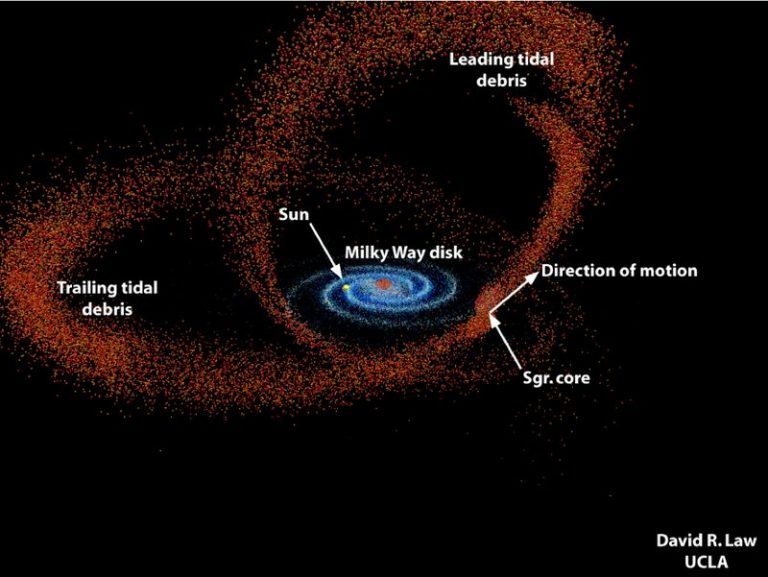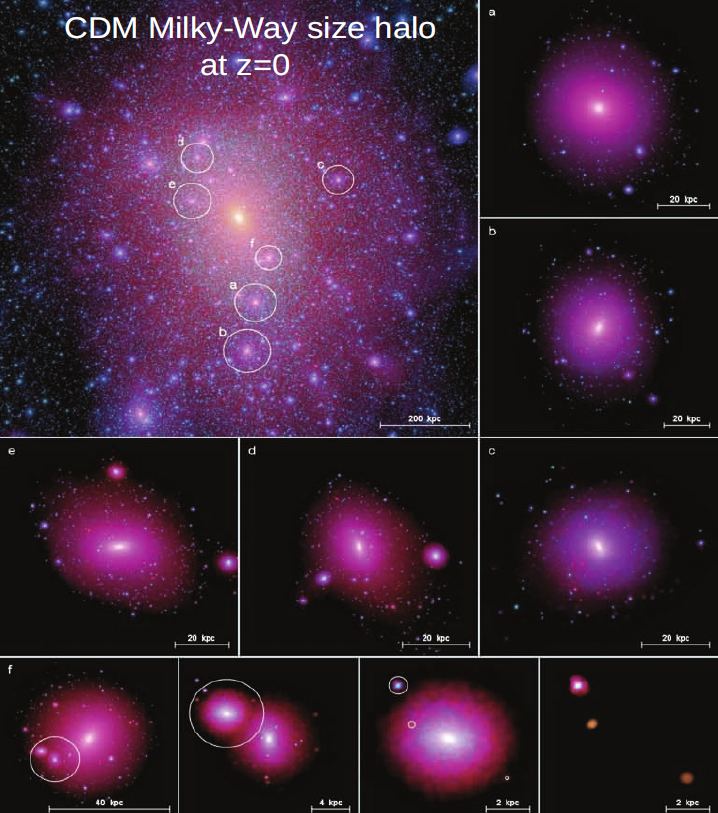The Milky Way is ancient and massive, a collection of hundreds of billions of stars, some dating back to the Universe's early days. During its long life, it's grown to these epic proportions through mergers with other, smaller galaxies. These mergers punctuate our galaxy's history, and its story is written in the streams of stars left behind as evidence after a merger.
And it's still happening today.
The Milky Way is currently digesting smaller galaxies that have come too close. The Large and Small Magellanic Clouds feel the effects as the Milky Way's powerful gravity distorts them and siphons a stream of gas and stars from them to our galaxy. A similar thing is happening to the Sagittarius Dwarf Spheroidal Galaxy and globular clusters like Omega Centauri.
There's a long list of these stellar streams in the Milky Way, though the original galaxies that spawned them are long gone, absorbed by the Milky Way. But the streams still tell the tale of ancient mergers and absorptions. They hold kinematic and chemical clues to the galaxies and clusters they spawned in.
Loading tweet...
— View on Twitter, CC BY-SA 4.0, https://commons.wikimedia.org/w/index.php?curid=114370789" src="/article_images/1280px-Stellar_streams_2022_S5survey-1024x515.jpg" />As astronomers get better tools to find and study these streams, they're realizing the streams could tell them more than just the history of mergers. They're like strings of pearls, and their shapes and other properties show how gravity has shaped them. But they also reveal something else important: how dark matter has shaped them.
Since dark matter is so mysterious, any chance to learn something about it is a priority. As researchers examine the stellar streams, they're finding signs of disturbances in them—including missing members—that aren't explained by the Milky Way's mass. They suspect that dark matter is the cause.
"If we find a pearl necklace with a few scattered pearls nearby, we can deduce that something may have come along and broken the string."
Soon, astronomers will have an enormously powerful tool to study these streams and dark matter's role in disturbing them: the Vera Rubin Observatory (VRO).
Astronomers have different methods of studying dark matter. Weak gravitational lensing is one of them, and it maps dark matter on the large scale of galaxy clusters. But stellar streams are at the opposite end of the scale. By mapping them and their irregularities and disturbances, astronomers can study dark matter at a much smaller scale.
The Rubin Observatory will complete its Legacy Survey of Space and Time (LSST) in a ten-year period. Alongside its time-domain astronomy objectives, the LSST will also study dark matter. The LSST Dark Energy Science Collaboration is aimed at dark matter and will use Rubin's power to advance the study of dark energy and dark matter like nothing before it. "LSST will go much further than any of its predecessors in its ability to measure the growth of structure and will provide a stringent test of theories of modi?ed-gravity," their website explains.
As we get closer and closer to the observatory's planned first light in January 2025, the growing excitement is palpable.
"I'm really excited about using stellar streams to learn about dark matter," said Nora Shipp, a postdoctoral fellow at Carnegie Mellon University and co-convener of the Dark Matter Working Group in the Rubin Observatory/LSST Dark Energy Science Collaboration. "With Rubin Observatory we'll be able to use stellar streams to figure out how dark matter is distributed in our galaxy from the largest scales down to very small scales."
Astronomers have ample evidence that a halo of dark matter envelops the Milky Way. Other galaxies are the same. These dark matter halos extend beyond a galaxy's visible disk and are considered basic units in the Universe's large-scale structure. These haloes may also contain sub-haloes, clumps of dark matter bound by gravity.
These clumps are what astronomers think are leaving their marks on stellar streams. The dark matter clumps create kinks and gaps in the streams. The VRO has the power to see these irregularities on a small scale and over a ten-year span. "By observing stellar streams, we'll be able to take indirect measurements of the Milky Way's dark matter clumps down to masses lower than ever before, giving us really good constraints on the particle properties of dark matter," said Shipp.
The Lambda Cold Dark Matter (Lambda CDM) model is the standard model of Big Bang Cosmology. One of the Lambda CDM's key predictions says that many sub-galactic dark matter substructures should exist. Astronomers want to test that prediction by observing these structures' effect on stellar streams. The VRO will help them do that and will also help them find more of them and build a larger data set.
Stellar streams are difficult to detect. Their kinematics give them away, but sometimes, there are only a few dozen stars in the streams. This obscures them among the Milky Way's myriad stars. But the VRO will change that.
The VRO will detect streams at much further distances. On the outskirts of the Milky Way, the streams have interacted with less matter, making them strong candidates for studying the effect of dark matter in isolation.
"Stellar streams are like strings of pearls, whose stars trace the path of the system's orbit and have a shared history," said Jaclyn Jensen, a PhD candidate at the University of Victoria. Jensen plans to use Rubin/LSST data for her research on the progenitors of stellar streams and their role in forming the Milky Way. "Using properties of these stars, we can determine information about their origins and what kind of interactions the stream may have experienced. If we find a pearl necklace with a few scattered pearls nearby, we can deduce that something may have come along and broken the string."
The VRO's powerful digital camera and its system of filters make this possible. Its ultraviolet filter, in particular, will help make more streams visible. Astronomers can distinguish stellar streams from all other stars by examining the blue-ultraviolet light at the end of the visible spectrum. They'll have thousands upon thousands of images to work with.
In fact, the VRO will unleash a deluge of astronomical data that scientists and institutions have been preparing to handle. AI and machine learning will play a foundational role in managing all that data, which should contribute to finding even more stellar streams.
"Right now it's a labor-intensive process to pick out potential streams by eye—Rubin's large volume of data presents an exciting opportunity to think of new, more automated ways to identify streams."
Astronomers are still finding more stellar streams. Earlier this month, a paper in The Astrophysical Journal presented the discovery of another one. Researchers found it in Gaia's Data Release 3. It's likely associated with the merger of the Sequoia dwarf galaxy.
It seems certain that astronomers will keep finding more stellar streams. Their value as tracers of the Milky Way's history is considerable. But if scientists can use them to understand the distribution of dark matter on a small scale, they'll get more than they bargained for.
 Universe Today
Universe Today



